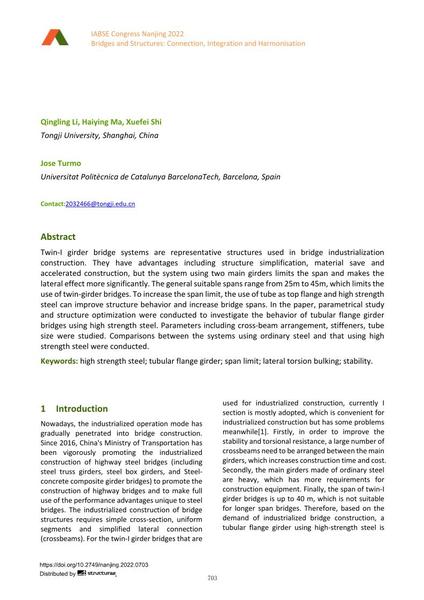Analytical Study on Tubular Flange Girder Bridges Using High Strength Steel

|
|
|||||||||||
Bibliographic Details
| Author(s): |
Qingling Li
(Tongji University, Shanghai, China)
Haiying Ma Xuefei Shi (Tongji University, Shanghai, China) José Turmo |
||||
|---|---|---|---|---|---|
| Medium: | conference paper | ||||
| Language(s): | English | ||||
| Conference: | IABSE Congress: Bridges and Structures: Connection, Integration and Harmonisation, Nanjing, People's Republic of China, 21-23 September 2022 | ||||
| Published in: | IABSE Congress Nanjing 2022 | ||||
|
|||||
| Page(s): | 703-709 | ||||
| Total no. of pages: | 7 | ||||
| DOI: | 10.2749/nanjing.2022.0703 | ||||
| Abstract: |
Twin-I girder bridge systems are representative structures used in bridge industrialization construction. They have advantages including structure simplification, material save and accelerated construction, but the system using two main girders limits the span and makes the lateral effect more significantly. The general suitable spans range from 25m to 45m, which limits the use of twin-girder bridges. To increase the span limit, the use of tube as top flange and high strength steel can improve structure behavior and increase bridge spans. In the paper, parametrical study and structure optimization were conducted to investigate the behavior of tubular flange girder bridges using high strength steel. Parameters including cross-beam arrangement, stiffeners, tube size were studied. Comparisons between the systems using ordinary steel and that using high strength steel were conducted. |
||||
| Keywords: |
stability high strength steel tubular flange girder span limit lateral torsion bulking
|
||||
| Copyright: | © 2022 International Association for Bridge and Structural Engineering (IABSE) | ||||
| License: | This creative work is copyrighted material and may not be used without explicit approval by the author and/or copyright owner. |
||||
